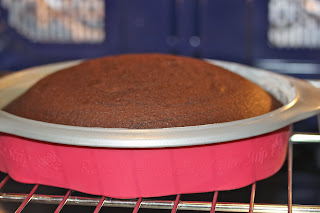We had some unchosen bananas this week...the ones that start to spot early and nobody wants to eat them, so they just keep getting darker. They looked like this by today:
So I decided a banana nut bread would be a good way to use them up. There used to be a roadside restaurant and fruit stand near Vacaville, CA, called the Nut Tree. They started out selling fruit, then nut breads, then they opened a restaurant, added some rides, and for several decades it was a great stopping off point between San Francisco and Lake Tahoe. Our favorite nut breads were the apricot walnut and, of course, banana nut. The Nut Tree is gone now, a victim of the times, I suppose, and the main thing I remember about the nut breads is how moist they were. So I went searching for a recipe, and came upon this one in Nancy Silverton's Pastries from the La Brea Bakery. She always seems to call for extra-large eggs, so I've started adding an extra large one to compensate (which I included in this recipe).
BANANA-NUT BREAD
2/3 cup (2 1/2 ounces) walnuts
2/3 cup (2 1/2 ounces) pecans
3 to 4 bananas, very ripe, mashed to equal 1 1/4 cups, plus 1 whole banana for garnish not so ripe
3 large eggs
1 1/2 teaspoons pure vanilla extract
1 stick (4 ounces) unsalted butter, slightly softened
1 1/4 teaspoons baking soda
2 1/2 teaspoons baking powder
3/4 teaspoon kosher salt
1 teaspoon ground cinnamon (I used Vietnamese)
3/4 teaspoon ground nutmeg
Scan 1/4 teaspoon ground cloves
1 Tablespoon poppy seeds
1/2 cup granulated sugar, plus 1 teaspoon extra for sprinkling
1/4 cup plus 2 Tablespoons light brown sugar, lightly packed
1 1/2 cups unbleached AP flour
Lightly butter a 6-cup-capacity loaf pan.
I have tried different brushes, but I find that it is worth it to spend a little more for pastry brushes. I buy a dozen at a time, and then I mark them with a Sharpie: butter, oil, and egg, because I suspect that there could be a little residue. Once they get funky looking, I throw them away.
Adjust the oven rack to the middle position and preheat the oven to 350 degrees. Spread the nuts on a baking sheet and toast them in the oven until lightly browned, about 10 minutes. Shake the pan halfway through to ensure that the nuts toast evenly (remember, you'll know they're done when you can smell them). Cool, chop coarsely, and set aside.
In a medium bowl, mash the riper bananas,
then whisk in eggs and vanilla extract to combine.
In the bowl of an electric mixer fitted with the paddle attachment, cream the butter, baking soda, baking powder, salt, cinnamon, nutmeg, cloves and poppy seeds on low, 2 to 3 minutes, until softened.
Add the sugars and turn the mixer up to medium, mixing another 3 to 4 minutes until fluffy, scraping down the sides of the bowl, if needed.
Add the flour and the banana mixture alternately in 3 batches, beginning with the flour and mixing until just combined.
Remove the bowl from the mixer and fold in the nuts.
Pour the batter into the prepared loaf pan to just below the rim.
Cut two 1/4-inch-thick strips from the remaining banana, slicing down the entire length.
Arrange the two C shapes on top of the loaf, staggered, with the two ends slightly interlocking with each other in the center (I didn't exactly follow this instruction...oops).
Sprinkle about one teaspoon granulated sugar over the surface.
Bake for 45 to 50 minutes, until nicely browned and firm to the touch.
Yield: 1 loaf
We all thought that this was a tasty nut bread. The spices are not overwhelming, and it was nice and moist on the inside. It will get even better in the freezer.


























































